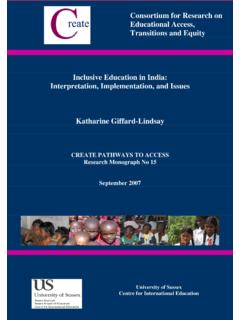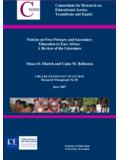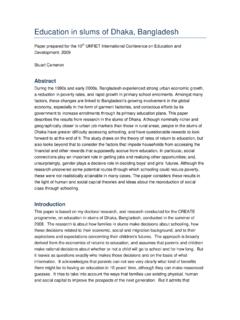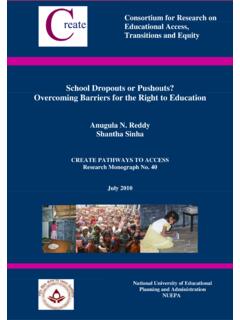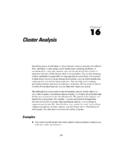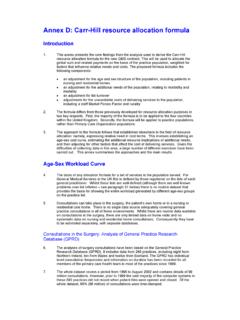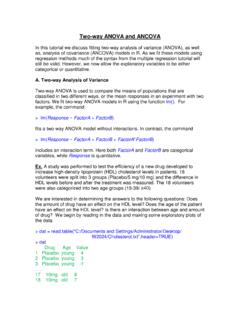Transcription of CREATE PATHWAYS TO ACCESS Research …
1 Consortium for Research on Educational ACCESS , Transitions and Equity Dropping Out from School: A Cross Country Review of Literature Frances Hunt CREATE PATHWAYS TO ACCESS . Research Monograph No 16. May 2008. University of Sussex Centre for International Education The Consortium for Educational ACCESS , Transitions and Equity ( CREATE ) is a Research Programme Consortium supported by the UK Department for International Development (DFID). Its purpose is to undertake Research designed to improve ACCESS to basic education in developing countries. It seeks to achieve this through generating new knowledge and encouraging its application through effective communication and dissemination to national and international development agencies, national governments, education and development professionals, non-government organisations and other interested stakeholders. ACCESS to basic education lies at the heart of development.
2 Lack of educational ACCESS , and securely acquired knowledge and skill, is both a part of the definition of poverty, and a means for its diminution. Sustained ACCESS to meaningful learning that has value is critical to long term improvements in productivity, the reduction of inter-generational cycles of poverty, demographic transition, preventive health care, the empowerment of women, and reductions in inequality. The CREATE partners CREATE is developing its Research collaboratively with partners in Sub-Saharan Africa and South Asia. The lead partner of CREATE is the Centre for International Education at the University of Sussex. The partners are: The Centre for International Education, University of Sussex: Professor Keith M Lewin (Director). The Institute of Education and Development, BRAC University, Dhaka, Bangladesh: Dr Manzoor Ahmed The National University of Educational Planning and Administration, Delhi, India: Professor R Govinda The Education Policy Unit, University of the Witwatersrand, South Africa: Dr Shireen Motala The Universities of Education at Winneba and Cape Coast, Ghana: Professor Jerome Djangmah The Institute of Education, University of London: Professor Angela W Little Disclaimer The Research on which this paper is based was commissioned by the Consortium for Research on Educational ACCESS , Transitions and Equity ( CREATE ).
3 CREATE is funded by the UK. Department for International Development (DFID) for the benefit of developing countries and is coordinated from the Centre for International Education, University of Sussex. The views expressed are those of the author(s) and not necessarily those of DFID, the University of Sussex, or the CREATE Team. Copyright CREATE 2008. ISBN: 0-901881-21-X. Address for correspondence: CREATE , Centre for International Education, Sussex School of Education, University of Sussex, Falmer, Brighton BN1 9QQ, United Kingdom Tel: + 44 (0) 1273 678464. Fax: + 44 (0) 1273 877534. Author Email: Website: Email: Please contact CREATE using the details above if you require a hard copy of this publication. Dropping Out from School: A Cross-Country Review of Literature Frances Hunt CREATE PATHWAYS TO ACCESS . Research Monograph No 16. May 2008. Contents Summary ..v 1 Background.
4 1. Research Methodological Approaches to Understanding School Dropout ..5. Organisation of the Review ..6. 2 Factors Influencing Drop Out and Household Income and Financial Circumstances ..7. School Fees and Indirect Costs of Schooling ..8. Income Shocks ..10. Child Household Contexts and Household Contexts ..17. Bereavement and Education of Household Household Perceived Benefits of Decision-Making Around Dropping Out ..23. Health of Health of Disability and special educational needs ..27. Social and Political Contexts ..30. Rural/Urban Other Socially Disadvantaged Conflict, Politically Fragile and Emergency Age, Marriage and Notions of Adulthood ..36. Supply of Schools ..37. The Role of School in Dropping Out: Schooling Quality, Processes and Practices ..37. Schooling Resources and Facilities ..38. Teaching and Learning ..39. Inclusions and Exclusions in Schooling Practices and School Environment and Safety Quality, Attainment and 3 Processes and Precursors to Dropping Repetition Versus Low Late Absenteeism and Temporary/Permanent Withdrawals from 4 Interventions: To Prevent Dropping Out and Encourage Dropping School-Related Factors.
5 47. Financial Support ..48. ii Quality Interventions ..49. Other Education Interventions ..49. 5 Discussion and Conclusions ..51. Gaps in Implications for CREATE Conclusions and Discussion ..52. Appendix One: CREATE 's Zones of Exclusion ..64. Appendix Two: Searching the Appendix Three: Examples of Quantitative Accounts of Reasons Behind Children Dropping Out from School ..66. List of Figures Figure 1: Drop Out Rates by Grade in Primary School in Figure 2: Drop Outs by Grade in Primary School in South List of Tables Table 1 GERS in Primary Education, Drop Out and Survival Rates % ..4. iii Preface Reducing drop out is central to improving ACCESS to basic education. Most of those who do not attend school are children who have enrolled but who have crossed the threshold from regular attendance to regular absence. In most countries the numbers excluded this way are much greater than those who never attend school.
6 In low enrolment systems more than half the children who start primary schooling will fail to complete it successfully. This review explores than many factors associated with drop out which lie at the individual, household, school and community level and maps how some of them interact. Often drop out is the result of a process rather than a single event, has more than one proximate cause, and is fairly irreversible. With older children demand rather than supply side variables may be more significant. This review identifies gaps in Research which CREATE plans to fill. These include insights into the process as well as the event of drop out, indicators of risk factors that could be used to predict drop out, opportunities and mechanisms that facilitate children to drop back in after they drop out, the impact of over age enrolment and repetition on drop out, and school friendliness factors that may promote higher rather than lower levels of attendance.
7 There are also many other insights from the literature that are presented and which could form the basis of new enquiries. This comprehensive overview of drop out is a good starting point for any researcher seeking to unpack the processes that lead to exclusion and identify the most important causes. Professor Keith M. Lewin Director, CREATE . University of Sussex iv Summary This paper provides an in-depth review and analysis of literature on dropping out from school, and focuses on children who have gained ACCESS , but fail to complete a basic education cycle. The main discussion is around why and how children drop out from school. Here drop out is not presented as a distinct event, but rather a process where a range of supply-demand factors interact to influence schooling ACCESS . The paper looks at literature in relation to household, community and social contexts of dropping out, as well as school supply and practices.
8 It also explores what Research is saying around pre-cursors to dropping out and factors which may influence retention. Finally, the study identifies gaps in Research around dropping out and how CREATE . Research could address some of these. v 1 Introduction Purpose This study provides an in-depth review and analysis on school drop outs taken from academic and development agency literature. It looks at the issues involved in dropping out from school in different situational contexts, and develops shared understandings of dropping out across the contexts. The study asks questions about what we know about drop outs and identifies where there might be gaps in Research knowledge. Dropping out from school occurs after children have previously achieved ACCESS to school. A major problem in many developing countries, dropping out is often obscured within statistical data and by the emphasis on initial ACCESS .
9 This study is concerned with children who have not completed a cycle of basic education, which depending on the compulsory age of enrolment, should generally encompass children from the ages of five or six to fifteen years (if initial enrolment takes place at the correct age). The study locates the issue of drop outs at a macro level providing statistical data around drop outs, but the discussion mainly focuses on and around qualitative accounts of dropping out. While statistical data can highlight the problem, less is known about the processes of drop out, and the reasons why and how it occurs. This report brings together previous Research done in this area, with a particular focus on case study, qualitative Research where available. It looks at the push/pull factors in both schools, communities and households which factor into dropping out. In terms of CREATE 's Zones of Exclusion, the particular emphasis of this study is on Zones 2, 3.
10 And 5 (see Appendix One), which takes into account dropping out from both primary and secondary schooling. Given CREATE 's focus on ACCESS to education in South Asia and Sub Saharan Africa, these geographical areas are given prominence within the paper, although studies on other areas are used to raise particular issues. The study is important because it brings together a range of literature on drop outs in a way that has not happened before. Drop out is an under-researched area, even though the problem is prevalent. With EFA and MDGs targeting ACCESS to education, knowledge around drop outs and studies such as this, can help illuminate some of the complexities around dropping out and bring new insights to policy makers and educational practitioners. By understanding drop outs further there will be greater potential to move towards a more meaningful notion of ACCESS .

